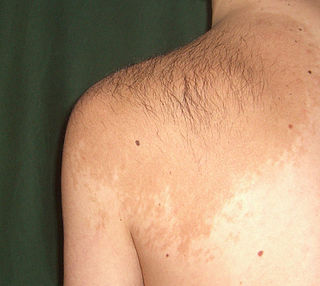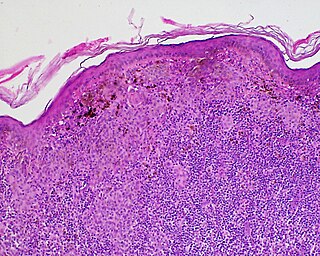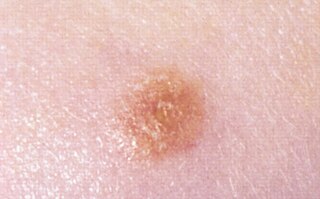
A melanocytic nevus is a type of melanocytic tumor that contains nevus cells.

Slate grey nevus is a benign, flat, congenital birthmark, with wavy borders and an irregular shape. In 1883, it was described and named after Mongolians by Erwin Bälz, a German anthropologist based in Japan, who erroneously believed it to be most prevalent among his Mongolian patients. It normally disappears three to five years after birth and almost always by puberty. The most common color is blue, although they can be blue-gray, blue-black or deep brown.

A dysplastic nevus or atypical mole is a nevus (mole) whose appearance is different from that of common moles. In 1992, the NIH recommended that the term "dysplastic nevus" be avoided in favor of the term "atypical mole". An atypical mole may also be referred to as an atypical melanocytic nevus, atypical nevus, B-K mole, Clark's nevus, dysplastic melanocytic nevus, or nevus with architectural disorder.

The congenital melanocytic nevus is a type of melanocytic nevus found in infants at birth. This type of birthmark occurs in an estimated 1% of infants worldwide; it is located in the area of the head and neck 15% of the time.

Becker's nevus is a skin disorder predominantly affecting males. The nevus can be present at birth, but more often shows up around puberty. It generally first appears as an irregular pigmentation on the torso or upper arm, and gradually enlarges irregularly, becoming thickened and often hairy (hypertrichosis). The nevus is due to an overgrowth of the epidermis, pigment cells (melanocytes), and hair follicles. This form of nevus was first documented in 1948 by American dermatologist Samuel William Becker (1894–1964).
Blaschko's lines, also called the lines of Blaschko, named after Alfred Blaschko, are lines of normal cell development in the skin. These lines are invisible under normal conditions. They become apparent when some diseases of the skin or mucosa manifest themselves according to these patterns. They follow a "V" shape over the back, "S" shaped whirls over the chest and sides, and wavy shapes on the head.

Blue nevus is a type of melanocytic nevus. The blue colour is caused by the pigment being deeper in the skin than in ordinary nevi. In principle they are harmless but they can sometimes be mimicked by malignant lesions, i.e. some melanomas can look like a blue nevus.

Halo nevus is a mole that is surrounded by a depigmented ring or 'halo'.

Nevus anemicus is a congenital disorder characterized by macules of varying size and shape that are paler than the surrounding skin and cannot be made red by trauma, cold, or heat. The paler area is due to the blood vessels within the area which are more sensitive to the body’s normal vasoconstricting chemicals.
Linear and whorled nevoid hypermelanosis is a disorder of pigmentation that develops within a few weeks of birth and progresses for one to two years before stabilizing. There is linear and whorled hyperpigmentation following the lines of Blaschko without preceding bullae or verrucous lesions. It is important to exclude other pigmentary disorders following the Blaschko lines before making a diagnosis of linear and whorled nevoid hypermelanosis. The differential diagnoses include incontinentia pigmenti, linear epidermal nevus, hypomelanosis of Ito and Goltz syndrome. Recently, a case of linear and whorled nevoid hypermelanosis was reported in a Malaysian Chinese girl.

A Spitz nevus is a benign skin lesion. A type of melanocytic nevus, it affects the epidermis and dermis.

Nevus sebaceus or sebaceous nevus is a congenital, hairless plaque that typically occurs on the face or scalp. Such nevi are present at birth, or early childhood, affecting males and females of all races equally. The condition is named for an overgrowth of sebaceous glands in the area of the nevus.

Linear verrucous epidermal nevus is a skin lesion characterized by a verrucous skin-colored, dirty-gray or brown papule. Generally, multiple papules present simultaneously, and coalesce to form a serpiginous plaque. When this nevus covers a diffuse or extensive portion of the body's surface area, it may be referred to as a systematized epidermal nevus, when it involved only one-half of the body it is called a nevus unius lateris.
Epidermal nevus syndrome is a rare disease that was first described in 1968 and consists of extensive epidermal nevi with abnormalities of the central nervous system (CNS), skeleton, skin, cardiovascular system, genitourinary system and eyes. However, since the syndrome's first description, a broader concept for the "epidermal nevus" syndrome has been proposed, with at least six types being described:

Nevus spilus is a skin lesion that presents as a light brown or tan macule, speckled with smaller, darker macules or papules.. Prevalance is around 2%, according to a limited study by Kopf et al
Pseudomelanoma is a cutaneous condition in which melantic skin lesions clinically resemble a superficial spreading melanoma at the site of a recent shave removal of a melanocytic nevus.

Nevus depigmentosus is a loss of pigment in the skin which can be easily differentiated from vitiligo. Although age factor has not much involvement in the nevus depigmentosus but in about 19% of the cases these are noted at birth. Their size may however grow in proportion to growth of the body. The distribution is also fairly stable and are nonprogressive hypopigmented patches. The exact cause of nevus depigmentosus is still not clearly understood. A sporadic defect in the embryonic development has been suggested to be a causative factor. It has been described as "localised albinism", though this is incorrect. Those with nevus depigmentosus may be prone to sunburn due to the lack of pigment, and the patient should use good sun protection. Sunscreen should be applied to all exposed skin, since reduced tanning of normal skin will decrease the contrast with hypopigmented skin. Most patients with nevus depigmentosus do not pursue treatment for their lesion. There is no way to repigment the skin. If, however, the lesion is of cosmetic concern, camouflage makeup is effective. If the lesion is small one could also consider excision.














